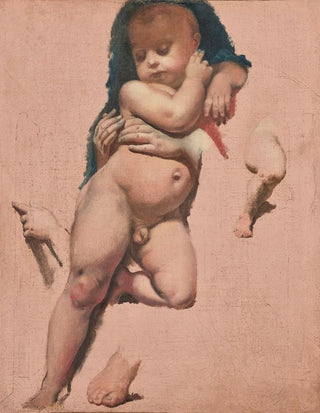Art print | Study for the Child Jesus of the vow of Louis XIII in the Montauban Cathedral - Jean-Auguste-Dominique Ingres


View from behind

Frame (optional)
Jean Auguste Dominique Ingres’s artwork, "Art print for the Study of the Child Jesus of the Vow of Louis XIII in Montauban Cathedral," fits within an artistic tradition where the sacred and the profane meet in rare harmony. Ingres, a master of neoclassicism, manages to capture the very essence of devotion through delicate strokes and carefully orchestrated compositions. This study, which precedes a monumental work, demonstrates the artist’s ability to transcend simple sketches to offer a deeply emotional vision. By immersing oneself in this piece, the viewer is invited to explore the subtleties of expressions and postures, thus revealing a palpable spirituality.
Style and uniqueness of the work
The originality of this study lies in how Ingres merges realism and idealization. Every detail, from the angelic face of the Child Jesus to the flowing drapery surrounding him, is meticulously crafted to evoke timeless beauty. The delicate colors, though subdued, breathe vibrant life into the scene. Precise lines and elegantly emphasized contours testify to undeniable technical mastery, characteristic of Ingres’s style. Furthermore, the use of light and shadow creates an almost mystical atmosphere, transporting the viewer to the heart of a spiritual experience. This work does not merely depict a religious subject; it invites deep contemplation, where each gaze reveals new nuances of meaning.
The artist and his influence
Jean Auguste Dominique Ingres, an emblematic figure of the 19th century, left a mark on art history with his unique vision and rigorous approach. Trained in the workshop of Jacques-Louis David, he distanced himself from the conventions of his time to develop a personal style, combining precision and sensitivity. His influence extends far beyond his contemporaries, impacting generations of artists who saw in him a model of artistic integrity. Ingres always advocated the importance of study and observation, which

Matte finish

View from behind

Frame (optional)
Jean Auguste Dominique Ingres’s artwork, "Art print for the Study of the Child Jesus of the Vow of Louis XIII in Montauban Cathedral," fits within an artistic tradition where the sacred and the profane meet in rare harmony. Ingres, a master of neoclassicism, manages to capture the very essence of devotion through delicate strokes and carefully orchestrated compositions. This study, which precedes a monumental work, demonstrates the artist’s ability to transcend simple sketches to offer a deeply emotional vision. By immersing oneself in this piece, the viewer is invited to explore the subtleties of expressions and postures, thus revealing a palpable spirituality.
Style and uniqueness of the work
The originality of this study lies in how Ingres merges realism and idealization. Every detail, from the angelic face of the Child Jesus to the flowing drapery surrounding him, is meticulously crafted to evoke timeless beauty. The delicate colors, though subdued, breathe vibrant life into the scene. Precise lines and elegantly emphasized contours testify to undeniable technical mastery, characteristic of Ingres’s style. Furthermore, the use of light and shadow creates an almost mystical atmosphere, transporting the viewer to the heart of a spiritual experience. This work does not merely depict a religious subject; it invites deep contemplation, where each gaze reveals new nuances of meaning.
The artist and his influence
Jean Auguste Dominique Ingres, an emblematic figure of the 19th century, left a mark on art history with his unique vision and rigorous approach. Trained in the workshop of Jacques-Louis David, he distanced himself from the conventions of his time to develop a personal style, combining precision and sensitivity. His influence extends far beyond his contemporaries, impacting generations of artists who saw in him a model of artistic integrity. Ingres always advocated the importance of study and observation, which






